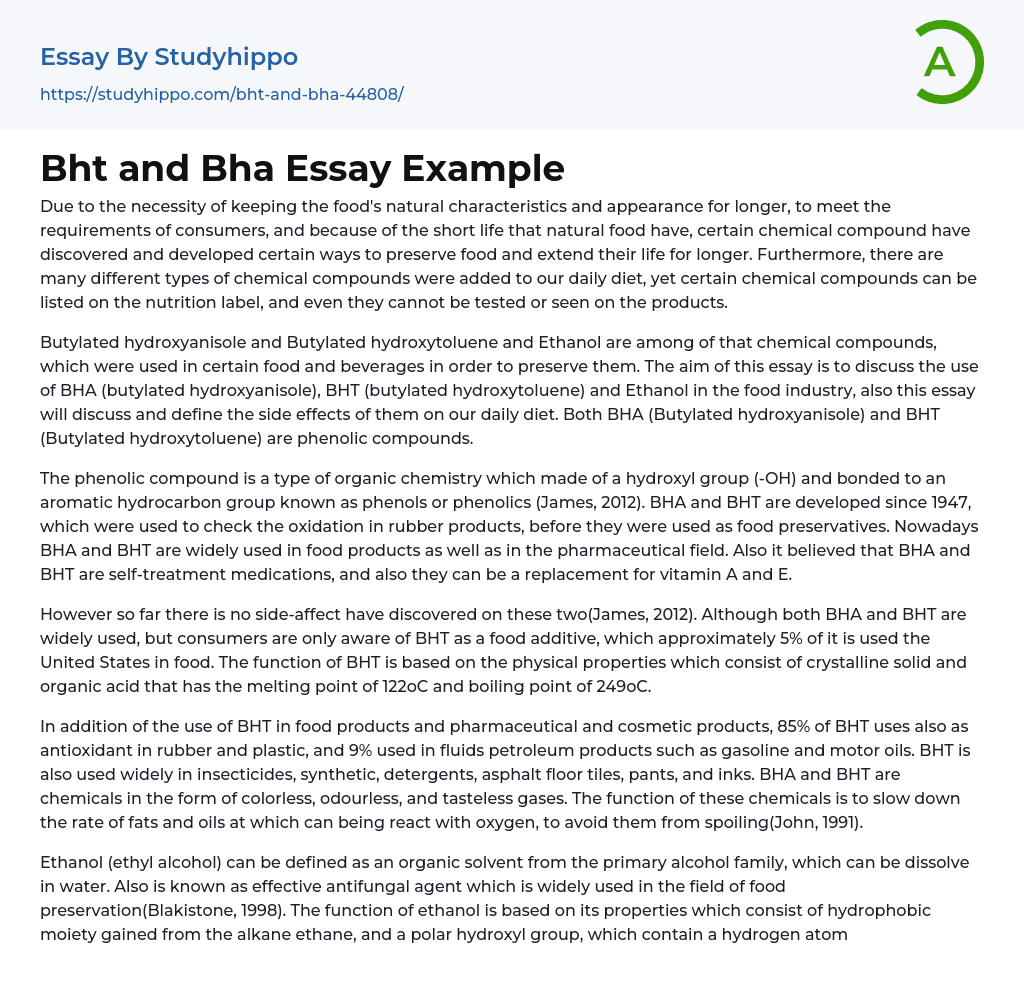
Chemical compounds are created to improve the longevity and strength of natural food, meeting consumers' need for products that last longer and look appealing. However, these compounds might not always be mentioned on nutrition labels or easily detectable in the products.
This essay examines the utilization and potential side effects of butylated hydroxyanisole (BHA), butylated hydroxytoluene (BHT), and ethanol in preserving food and beverages within the food industry. It emphasizes that both BHA and BHT are phenolic compounds.
The phenolic compound, also referred to as phenols or phenolics, is a type of organic chemistry compound that includes a hydroxyl group (-OH) linked to an aromatic hydrocarbon group (James, 2012). Originally created in 1947 for the purpose of preventing oxidation in rubber products, BHA and BHT are now widely utilized as preservatives in f
...ood by both the food industry and the pharmaceutical industry. Furthermore, there is a belief that BHA and BHT can function as replacements for vitamin A and E and serve self-treatment purposes.
According to James (2012), BHA and BHT are substances that do not have any known side effects. Although both substances are commonly used, consumers are only familiar with BHT being used as a food additive, with approximately 5% of it being used in US food. BHT works by utilizing its characteristics as a crystalline solid and an organic acid, with a melting point of 122°C and boiling point of 249°C.
BHT is utilized in multiple industries including food products, pharmaceuticals, cosmetics, rubber and plastics. It is also present in petroleum products such as gasoline and motor oils. Additionally, it is frequently employed in insecticides, synthetic materials, detergents,
asphalt floor tiles, paints, and inks. Both BHA and BHT are gaseous substances that lack color, odor, and taste. Their function is to hinder the oxidation process of fats and oils to prevent their deterioration (John, 1991).
Ethanol, also referred to as ethyl alcohol, is a primary alcohol and organic solvent that has the ability to dissolve in water. It is widely utilized for preserving food (Blakistone, 1998). The antifungal properties of ethanol are due to its distinct characteristics derived from ethane, an alkane, and a polar hydroxyl group containing a hydrogen atom bonded to oxygen - an electronegative element. In the food industry, ethanol acts as a preservative and plays a significant role in specific food products. Since 1976, it has been added to bakery products in the United States which enhances taste and prolongs shelf life prior to packaging. Ethanol not only effectively inhibits microbial growth but also helps delay the staling process of bread and cake (Russell, 2003). Overall, successful preservation of food involves creating an environment that hinders bacterial activity and growth in order to prevent spoilage.
Both BHT and BHA, which are antioxidants, are frequently used as preservatives in food, beverages, cosmetics, and pharmaceuticals (John, h. 1991). Furthermore, ethanol is utilized in the food industry as a preservative to enhance flavor and extend the shelf life of certain cakes and breads before they are packaged.
Moreover, ethanol has extensive usage not only in the preservation of food but also in herbal and alternative medicine (Blakistone, 1998).
Bibliography:
- Blakistone. B. (1998) Principle and Applications of Modified Atmosphere Packaging of Foods. Chapman & Hall.
- James. A. (2012) General, Organic,
and Biochemistry. Brooks/Cole.
- John. H, Cheryl. H, Richard. S, Christine. S. (1991) Toxics A to Z. The Regents of the University of California.
- Russell.I, Gould.G.(2003) Food Preservatives.Kluwer Academic/Plenum Publishers New York.
- Food Safety essays
- Food Security essays
- Beverages essays
- Cuisines essays
- Dairy essays
- Desserts essays
- Fast Food essays
- Bread essays
- Meal essays
- Meat essays
- Organic Food essays
- Rice essays
- Sugar essays
- Taste essays
- Beef essays
- Coconut essays
- Crowd essays
- Dinner essays
- Juice essays
- Sainsbury essays
- Cooking essays
- Ginger essays
- Oreo essays
- Drink essays
- Beer essays
- Wine essays
- Coffee essays
- Tea essays
- Cake essays
- Hamburger essays
- Ice Cream essays
- Burger essays
- Pizza essays
- Fruit essays
- Lemon essays
- Food Waste essays
- Favorite Food essays
- Alcoholic essays
- Soft Drinks essays
- Cookie essays
- Starch essays
- Yeast essays
- Cola essays
- Pizza Hut essays
- snack foods essays
- chips essays
- Biscuit essays
- Brewing essays
- Brewery essays
- Business Law essays



